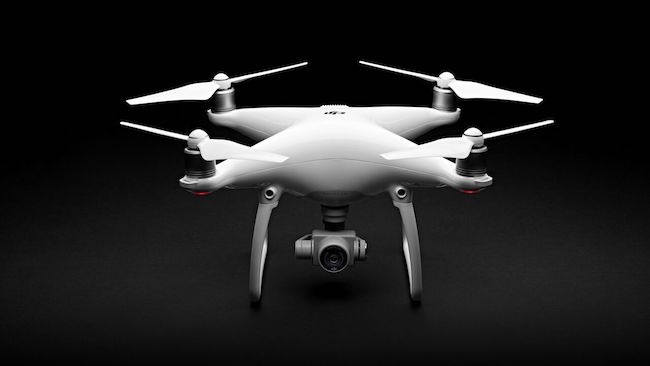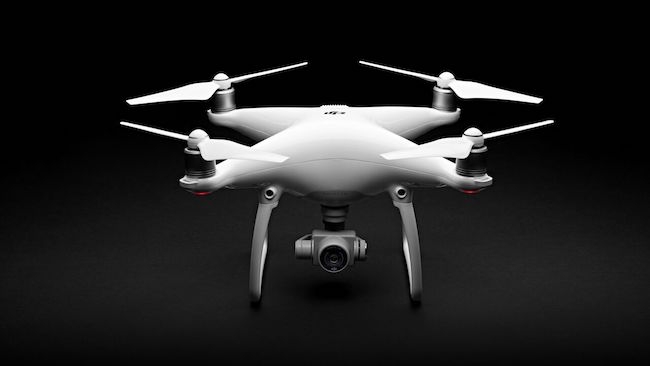
 The new, all-singing, all-flying Phantom 4
The new, all-singing, all-flying Phantom 4
As a sign that progress in the drone field is extremely rapid and that competition is becoming equally fierce, DJI has unveiled its latest Phantom 4 UAV under a year after the Phantom 3 debuted.
The market is, of course, also becoming increasingly crowded, as manufacturers like DJI seek to segment it and fill every possible niche with a slightly different variant.
The new Phantom 4 though does seem to genuinely put a certain amount of clear blue air between previous generations and its own base model, notably ramping up the degree of on-board intelligence in particular and powering a brace of new features with it as a result.
These include an Obstacle Sensing System, which features two forward-facing optical sensors that scan for obstacles and automatically direct the aircraft around them wherever possible; ActiveTrack which allows users to select an object on screen via the accompanying app which the drone camera will then automatically track; and TapFly which, in a similar fashion, allows users to double tap on a destination and the drone will head for it on an optimal flight path, navigating itself around any obstacles in the way.
For advanced pilots that can eschew such frivolities, a new Sport Mode takes top speed up to 45mph and is a nod to the increasingly popular sport of drone racing.
The Phantom 4 camera, meanwhile, now includes improved optics for better corner sharpness and reduced chromatic aberration; the classic Phantom form factor has been redesigned to be more aerodynamic and features a redesigned, repositioned and improved gimball; and flight time has been extended to 28 minutes.
Also extended has been the price. The Phantom 3 cost £899 when it was launched, the Phantom 4 is going to be £1229.
More details in the press release after the break…
DJI Launches New Era of Intelligent Flying Cameras
New DJI Phantom 4 features obstacle avoidance, intelligent tracking and a simplified flying experience
NEW YORK, March 1, 2016 – DJI, the world’s leading maker of unmanned aerial vehicles, on Tuesday launched the Phantom 4, the first consumer quadcopter camera (or “drone”) to use highly advanced computer vision and sensing technology to make professional aerial imaging easier for everyone.
The Phantom 4 expands on previous generations of DJI’s iconic Phantom line by adding new on-board intelligence that make piloting and shooting great shots simple through features like its Obstacle Sensing System, ActiveTrack and TapFly functionality.
“With the Phantom 4, we are entering an era where even beginners can fly with confidence,” said DJI CEO Frank Wang. “People have dreamed about one day having a drone collaborate creatively with them. That day has arrived.”
The Phantom 4’s Obstacle Sensing System features two forward-facing optical sensors that scan for obstacles and automatically direct the aircraft around the impediment when possible, reducing risk of collision, while ensuring flight direction remains constant. If the system determines the craft cannot go around the obstacle, it will slow to a stop and hover until the user redirects it. Obstacle avoidance also engages if the user triggers the drone’s “Return to Home” function to reduce the risk of collision when automatically flying back to its take off point.
With ActiveTrack, the Phantom 4 breaks new ground, allowing users running the DJI Go app on iOS and Android devices to follow and keep the camera centered on the subject as it moves simply by tapping the subject on their smartphone or tablet. Perfectly-framed shots of moving joggers or cyclists, for example, simply require activating the ActiveTrack mode in the app.
The Phantom 4 understands three-dimensional images and uses machine learning to keep the object in the shot, even when the subject changes its shape or turns while moving. Users have full control over camera movement while in ActiveTrack mode – and can even move the camera around the object while it is in motion as the Phantom 4 keeps the subject framed in the center of the shot autonomously. A “pause” button on the Phantom 4’s remote controller allows the user to halt an autonomous flight at any time, leaving the drone to hover.
By using the TapFly function in the DJI Go app, users can double-tap a destination for their Phantom 4 on the screen, and the Phantom 4 calculates an optimal flight route to reach the destination, while avoiding any obstructions in its path. Tap another spot and the Phantom 4 will smoothly transition towards that destination making even the beginner pilot look like a seasoned professional.
The Phantom 4’s camera, still the world’s best aerial-optimized 4K imaging device, has undergone an upgrade that includes improved optics for better corner sharpness and reduced chromatic aberration. The Phantom 4 also has DJI’s signature Lightbridge video transmission system onboard, allowing users to see what their camera sees in HD and in real-time on their smart devices at a distance up to five kilometers (3.1 miles).
The Phantom 4’s form factor, still the classic quadcopter style pioneered by DJI, has been redesigned and redefined to emphasize elegance and smoother, more-aerodynamic lines. Its frame incorporates a lightweight composite core to provide enhanced stability and more-agile flight. The core now features a redesigned gimbal that provides more stability and vibration dampening, and has been repositioned for a better center of gravity and to reduce the risk of propellers getting in the shot.
Refinements to motor efficiency, power management and a new intelligent battery have extended the Phantom 4’s flight time to 28 minutes, which means more time in the air to capture professional photos and video.
DJI crafted the Phantom 4 with reliability in mind, including redundant inertial measurement units (IMUs) and dual compasses onboard. It uses new push-and-lock propellers that are faster to install and more secure in flight.
In addition to intelligence and ease-of-use, the Phantom 4 is built for fun. Its new “Sport Mode” for advanced flyers gives a taste of what drone racing feels like. In “Sport Mode,” the Phantom 4 can fly 20 meters per second (45 miles per hour) and ascends and descends more rapidly than in other modes. The craft’s acceleration and top speed in “Sport Mode” also mean it can reach locations for shots faster and capture shots you couldn’t get before.
“Though the Phantom 4 is easy to use, let’s not forget it is a high-performance aircraft powered by unparalleled DJI technology,” said Senior Product Manager Paul Pan.
The Phantom 4’s UK retail price is GBP 1,229.
Availability from DJI and Apple
Pre-orders for the Phantom 4 will start March 1 on DJI.com and Apple.com, and customers will begin receiving their units on March 15. The Phantom 4 will also be available in-store at DJI's flagship stores and Apple stores around the world starting March 15.
Tags: Production


Comments